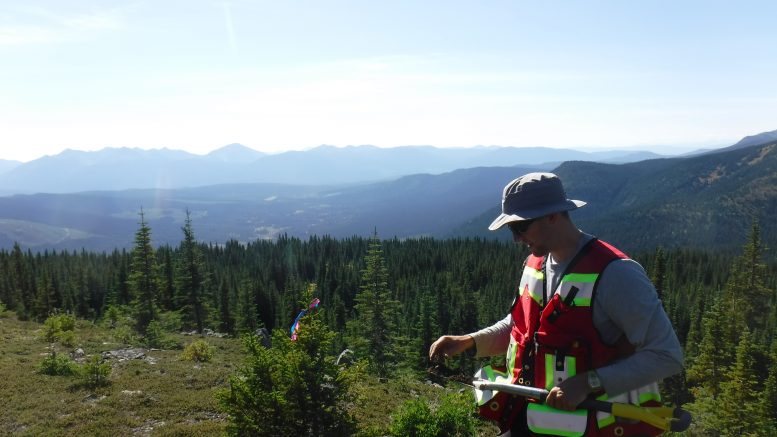
Sun Metals staff and management review 2017 drill core: Clockwise starting on left – Donald McInnes, Rick Bailes, Ron Simpson, Mark O’Dea, Steve Robertson, Bob Johnston and Gavin Titley. Credit: Sun Metals.
Newly formed Sun Metals has released positive drill results and an updated resource estimate on its optioned 96 sq. km Stardust polymetallic project, 150 km northwest of Fort St. James in central British Columbia.
The latest results from Sun Metals’ three-hole drill program include 5.2 metres from 83 metres downhole grading 0.44% copper, 2.99% zinc, 156.6 grams silver and 1.36 grams gold, as well as 4.4 metres from 90 metres downhole grading 332.6 grams silver and 3.36 grams gold. Each hole tested a different part of the geology: a zinc manto, a gold-copper skarn and a silver-gold vein.
Sun Metals president and CEO Steve Robertson says he’s encouraged by the results.
“The idea with that drilling was to go in and confirm the previously intersected mineralization,” Robertson says. “We didn’t actually want to twin holes. We wanted to get new data, but we drilled into areas where we were going to have a high confidence of intersecting mineralization, and we were very pleased with the results.”
Formerly called Lustdust, the Stardust property is next to the Kwanika Creek deposit on the Pinchi fault. Oxygen Capital picked up an option on the Stardust property from Lorraine Copper (TSXV: LLC) and formed Sun Metals in mid-2017 to get through an exploration program and gear up to go public by July 2018.
“The property was discovered back in the 1940s, and it has seen a steady stream of exploration ever since,” Robertson says. “The property has just recently come into our hands and we intend to do a full compilation of all that historic data.”
Before Sun Metals’ involvement, $25 million had been invested into Stardust across 390 holes and 80,000 metres of drilling. Sun Metals combined this data with its own for an updated resource estimate on the Canyon Creek copper-gold skarn zone.
Canyon Creek now has 985,000 indicated tonnes grading 1.34% copper, 1.59 grams gold per tonne and 36.8 grams silver per tonne, plus 1.96 million inferred tonnes grading 1.24% copper, 1.7 grams gold and 30.5 grams silver.
“Lorraine bought the property from the previous owner, which was Alpha Gold, and they were able to get the database that they had from them,” Robertson says. “Lorraine didn’t actually conduct any exploration work themselves.”
Lorraine still owns Stardust. To obtain its option, Sun Metals paid $100,000 to Lorraine Copper, issued 1 million shares and spent $500,000 on exploration in 2017. For a 100% interest on the property, Sun Metals must spend $6 million by the end of 2021. At this point, Lorraine’s share total in Sun Metals would increase to 30%. Lorraine would also retain a 2% net smelter return (NSR) royalty on precious metals and a 1% NSR royalty on base metals. Sun Metals can cut the royalties in half by paying $1.5 million per royalty to Lorraine.
Mineralization at Stardust trends northwest for 2.1 km over an integrated porphyry-skarn-epithermal system with carbonate replacement deposits (CRDs). Robertson says that from a geological perspective the project is fascinating.
“CRDs in general are very interesting,” Robertson says. “Quite often you only see a portion of the deposit. In this case we actually have the whole thing preserved right from the intrusive through the copper-gold skarn mineralization, and then into the zinc-rich mantos and out into the epithermal precious metal veins.”
Sun Metals is going public via a reverse takeover by North Bluff Capital (NEX: NBK.H) and plans to raise $5 to $10 million to fund exploration in 2018.
“We want to first of all better understand the system, and we would like to expand the resource,” Robertson says. “It’s going to be our flagship project as we move forward.”
Oxygen Capital is a private company with projects in the U.S., Mexico and Red Lake, Ont., in addition to British Columbia. It is a partial owner of Liberty Gold (TSX: LGD), Discovery Metals (TSXV: DSV) and Pure Gold Mining (TSXV: PGM).


Be the first to comment on "Sun Metals drills Stardust"